III.7.7 Pompeii. Vineyard.
Part 1 Part 2 Jashemski 1964, 1968 Part 3 Jashemski 1976 Part 4 Jashemski 1976 Part 5 Jashemski 1976

III.7 Pompeii. 1976. Looking south-east across site towards modern Pompeii. Photo by Stanley A. Jashemski.
Source: The Wilhelmina and Stanley A. Jashemski archive in the University of Maryland Library, Special Collections (See collection page) and made available under the Creative Commons Attribution-Non Commercial License v.4. See Licence and use details.
J76f0352

III.7 Pompeii. 1976. Looking south-east across triclinium, during the clearing of its lapilli. Photo by Stanley A. Jashemski.
Source: The Wilhelmina and Stanley A. Jashemski archive in the University of Maryland Library, Special Collections (See collection page) and made available under the Creative Commons Attribution-Non Commercial License v.4. See Licence and use details.
J76f0351

III.7 Pompeii. 1976.
The top of the table in the centre of the couches, which had been found damaged.
Photo by Stanley A. Jashemski.
Source: The Wilhelmina and Stanley A. Jashemski archive in the University of Maryland Library, Special Collections (See collection page) and made available under the Creative Commons Attribution-Non Commercial License v.4. See Licence and use details.
J76f0347

III.7 Pompeii. 1976. Clearing the lapilli from the triclinium, still covered in red stucco. Photo by Stanley A. Jashemski.
Source: The Wilhelmina and Stanley A. Jashemski archive in the University of Maryland Library, Special Collections (See collection page) and made available under the Creative Commons Attribution-Non Commercial License v.4. See Licence and use details.
J76f0348

III.7 Pompeii. 1976. Finds from near south wall, possibly from near the rear doorway of the house. Photo by Stanley A. Jashemski.
The circular object was difficult to explain by Wilhelmina.
It was made of cocciopesto (cement with crushed terracotta) and had a slight peak at its centre.
It had a somewhat similar shape to the masonry base that would have supported the mill in a bakery.
Nearby a heap of terracotta fragments of amphorae, and pots and pans of various kinds.
Source: The Wilhelmina and Stanley A. Jashemski archive in the University of Maryland Library, Special Collections (See collection page) and made available under the Creative Commons Attribution-Non Commercial License v.4. See Licence and use details.
J76f0350
See Jashemski, W.F., 2014. Discovering the Gardens of Pompeii: Memoirs of a Garden Archaeologist, (p. 246)

III.7 Pompeii. 1976.
Circular object made of cocciopesto (cement with crushed terracotta) with a slight peak at its centre. Photo by Stanley A. Jashemski.
Source: The Wilhelmina and Stanley A. Jashemski archive in the University of Maryland Library, Special Collections (See collection page) and made available under the Creative Commons Attribution-Non Commercial License v.4. See Licence and use details.
J76f0330

III.7 Pompeii. 1976. Fragments of amphorae and pots. Photo by Stanley A. Jashemski.
Source: The Wilhelmina and Stanley A. Jashemski archive in the University of Maryland Library, Special Collections (See collection page) and made available under the Creative Commons Attribution-Non Commercial License v.4. See Licence and use details.
J76f0349

III.7 Pompeii. 1976. Circular object, terracotta pots and a watering basin. Photo by Stanley A. Jashemski.
Source: The Wilhelmina and Stanley A. Jashemski archive in the University of Maryland Library, Special Collections (See collection page) and made available under the Creative Commons Attribution-Non Commercial License v.4. See Licence and use details.
J76f0359

III.7 Pompeii. 1976. Objects emerging from the lapilli. Photo by Stanley A. Jashemski.
Source: The Wilhelmina and Stanley A. Jashemski archive in the University of Maryland Library, Special Collections (See collection page) and made available under the Creative Commons Attribution-Non Commercial License v.4. See Licence and use details.
J76f0426

III.7 Pompeii. 1976. Objects emerging from the lapilli. Photo by Stanley A. Jashemski.
Source: The Wilhelmina and Stanley A. Jashemski archive in the University of Maryland Library, Special Collections (See collection page) and made available under the Creative Commons Attribution-Non Commercial License v.4. See Licence and use details.
J76f0427

III.7 Pompeii. 1976. Pot found in the lapilli. Photo by Stanley A. Jashemski.
Source: The Wilhelmina and Stanley A. Jashemski archive in the University of Maryland Library, Special Collections (See collection page) and made available under the Creative Commons Attribution-Non Commercial License v.4. See Licence and use details.
J76f0430

III.7 Pompeii. 1976.
Large red phallus discovered at the base of the wall. It was about 9 inches long. and broken into three pieces.
Found nearby was the tip of a smaller red phallus. Photo by Stanley A. Jashemski.
Source: The Wilhelmina and Stanley A. Jashemski archive in the University of Maryland Library, Special Collections (See collection page) and made available under the Creative Commons Attribution-Non Commercial License v.4. See Licence and use details.
J76f0435

III.7 Pompeii. 1976. The larger red phallus. Photo by Stanley A. Jashemski.
Source: The Wilhelmina and Stanley A. Jashemski archive in the University of Maryland Library, Special Collections (See collection page) and made available under the Creative Commons Attribution-Non Commercial License v.4. See Licence and use details.
J76f0441

III.7 Pompeii. 1976. Another find, emerging from the lapilli. Photo by Stanley A. Jashemski.
Source: The Wilhelmina and Stanley A. Jashemski archive in the University of Maryland Library, Special Collections (See collection page) and made available under the Creative Commons Attribution-Non Commercial License v.4. See Licence and use details.
J76f0437

III.7 Pompeii. 1976. Objects amongst the lapilli. Photo by Stanley A. Jashemski.
Source: The Wilhelmina and Stanley A. Jashemski archive in the University of Maryland Library, Special Collections (See collection page) and made available under the Creative Commons Attribution-Non Commercial License v.4. See Licence and use details.
J76f0432

III.7 Pompeii. 1976.
Found near the circular structure, was the top portion of a large amphora which had been turned upside down, so that it could be used as a brazier.
It was filled with a deep layer of ashes. A blackened pot was still in place on the ashes. Photo by Stanley A. Jashemski.
Source: The Wilhelmina and Stanley A. Jashemski archive in the University of Maryland Library, Special Collections (See collection page) and made available under the Creative Commons Attribution-Non Commercial License v.4. See Licence and use details.
J76f0360

III.7 Pompeii. 1976. Top part of large amphora, used as a brazier. Photo by Stanley A. Jashemski.
Source: The Wilhelmina and Stanley A. Jashemski archive in the University of Maryland Library, Special Collections (See collection page) and made available under the Creative Commons Attribution-Non Commercial License v.4. See Licence and use details.
J76f0433

III.7 Pompeii. 1976. Top part of large amphora, used as a brazier, and now free of the lapilli. Photo by Stanley A. Jashemski.
Source: The Wilhelmina and Stanley A. Jashemski archive in the University of Maryland Library, Special Collections (See collection page) and made available under the Creative Commons Attribution-Non Commercial License v.4. See Licence and use details.
J76f0448

III.7 Pompeii. 1976.
Two of Wilhelmina’s helpers, Raffaele and Renato, kneeling down and pretending to cook on the brazier. Photo by Stanley A. Jashemski.
Source: The Wilhelmina and Stanley A. Jashemski archive in the University of Maryland Library, Special Collections (See collection page) and made available under the Creative Commons Attribution-Non Commercial License v.4. See Licence and use details.
J76f0478
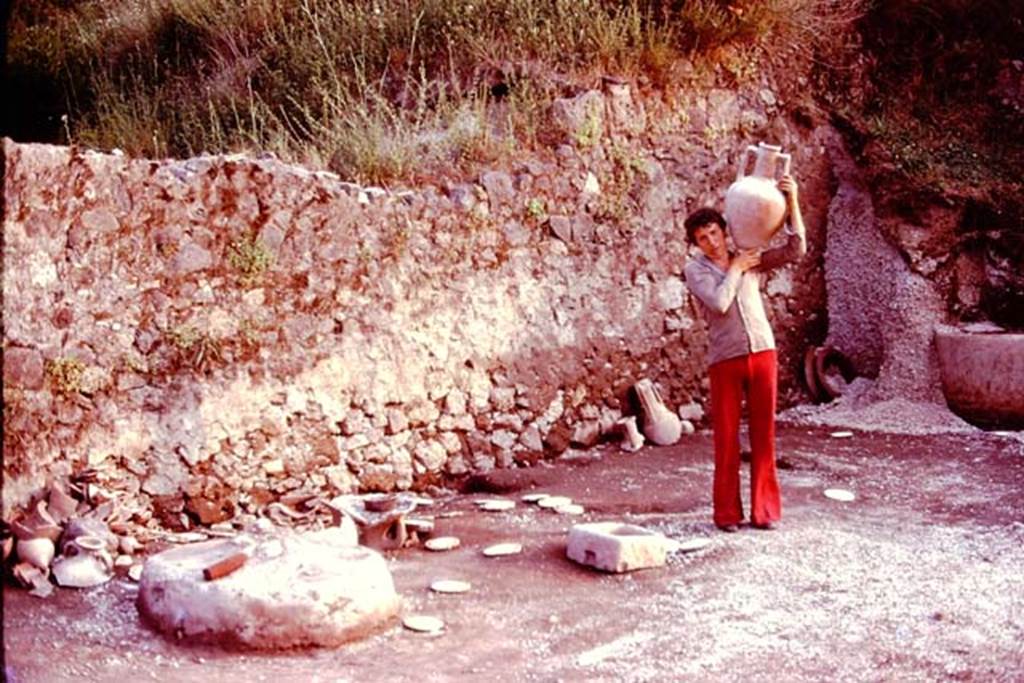
III.7 Pompeii. 1976. South-west corner of site, with gathered finds. Photo by Stanley A. Jashemski.
Source: The Wilhelmina and Stanley A. Jashemski archive in the University of Maryland Library, Special Collections (See collection page) and made available under the Creative Commons Attribution-Non Commercial License v.4. See Licence and use details.
J76f0479
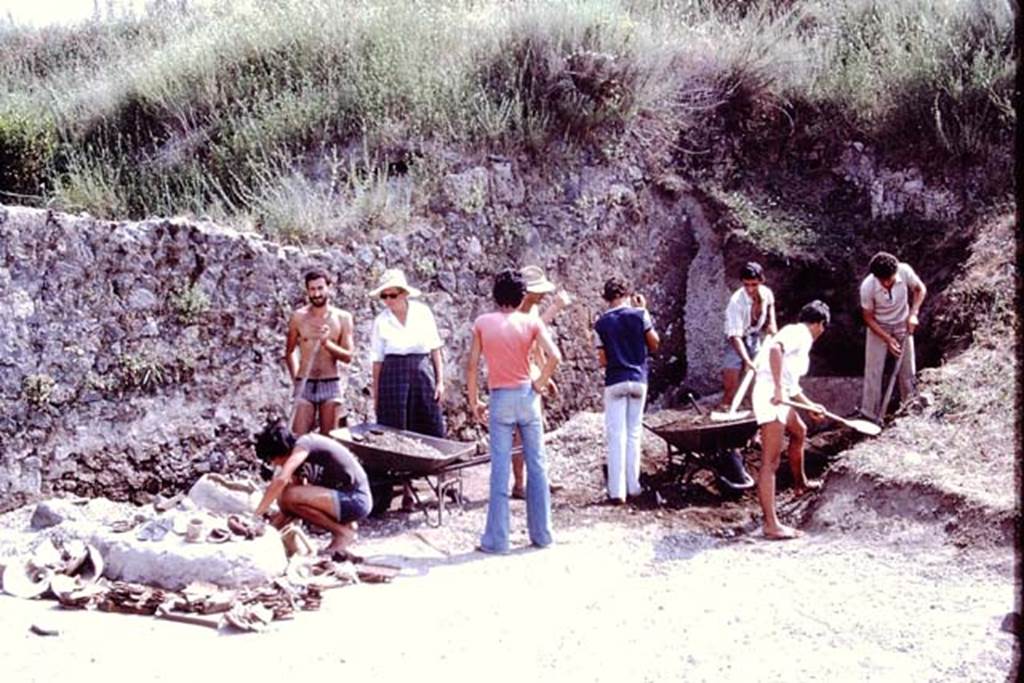
III.7 Pompeii. 1976. Looking towards the south-west corner of the area. Photo by Stanley A. Jashemski.
Source: The Wilhelmina and Stanley A. Jashemski archive in the University of Maryland Library, Special Collections (See collection page) and made available under the Creative Commons Attribution-Non Commercial License v.4. See Licence and use details.
J76f0438
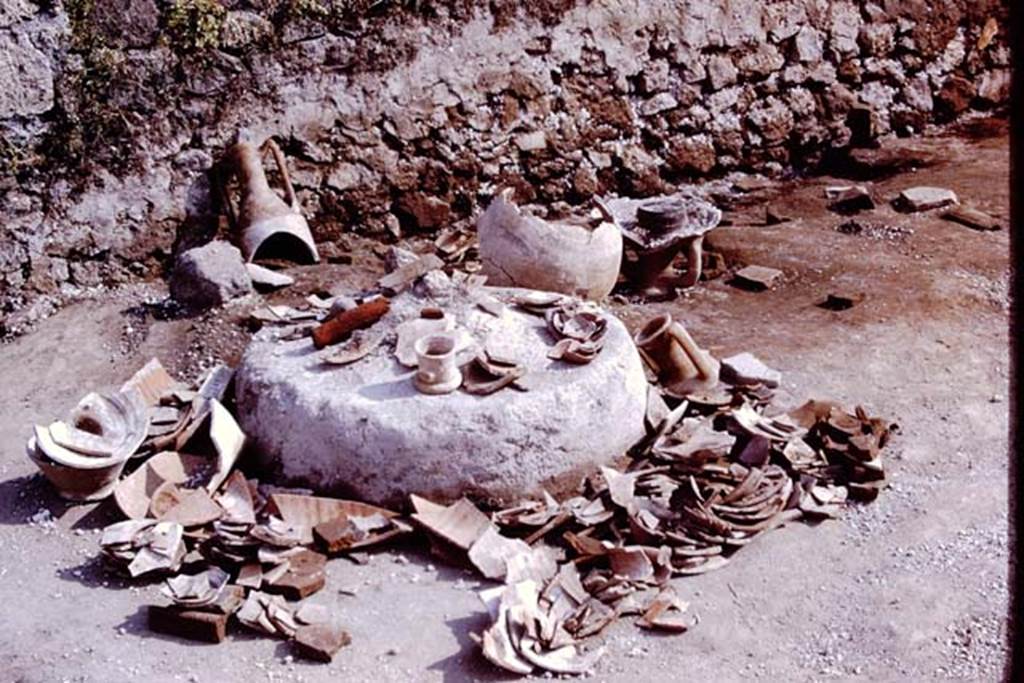
III.7 Pompeii. 1976. Many finds spread out on the circular object. Photo by Stanley A. Jashemski.
Source: The Wilhelmina and Stanley A. Jashemski archive in the University of Maryland Library, Special Collections (See collection page) and made available under the Creative Commons Attribution-Non Commercial License v.4. See Licence and use details.
J76f0442
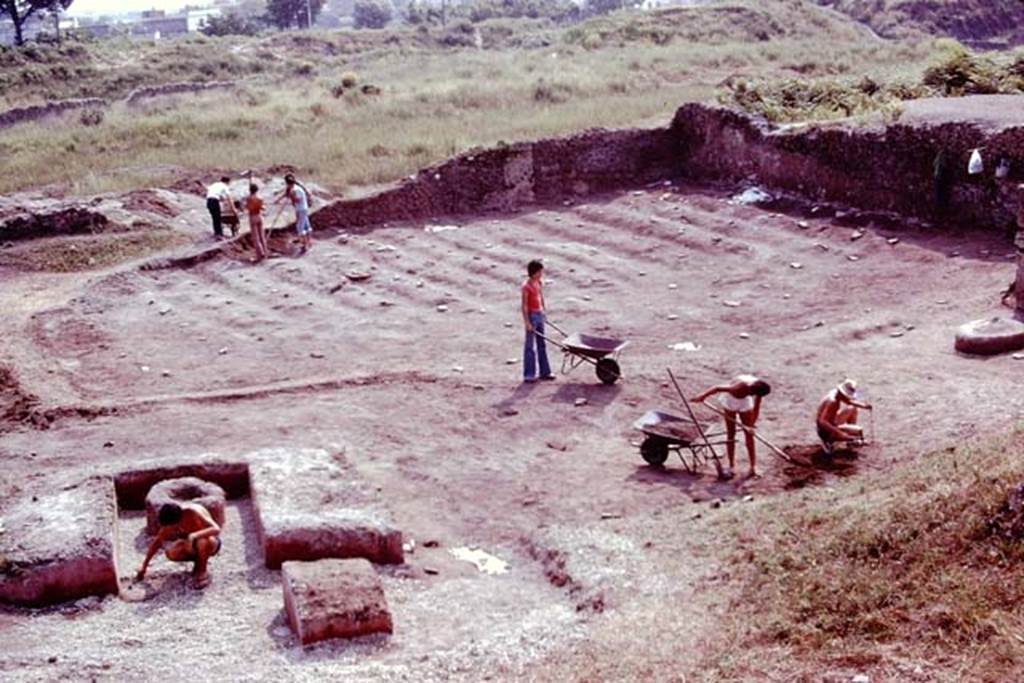
III.7 Pompeii. 1976. Looking south-east across site. Photo by Stanley A. Jashemski.
Source: The Wilhelmina and Stanley A. Jashemski archive in the University of Maryland Library, Special Collections (See collection page) and made available under the Creative Commons Attribution-Non Commercial License v.4. See Licence and use details.
J76f0363
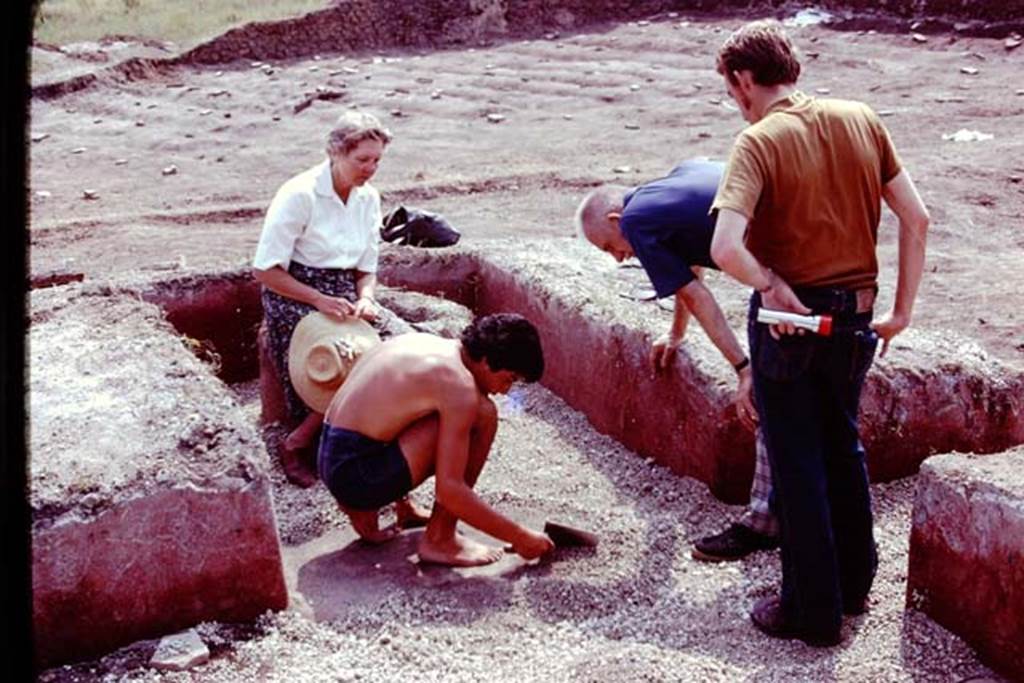
III.7 Pompeii. 1976. Examining the lapilli near the triclinium. Photo by Stanley A. Jashemski.
Source: The Wilhelmina and Stanley A. Jashemski archive in the University of Maryland Library, Special Collections (See collection page) and made available under the Creative Commons Attribution-Non Commercial License v.4. See Licence and use details.
J76f0367
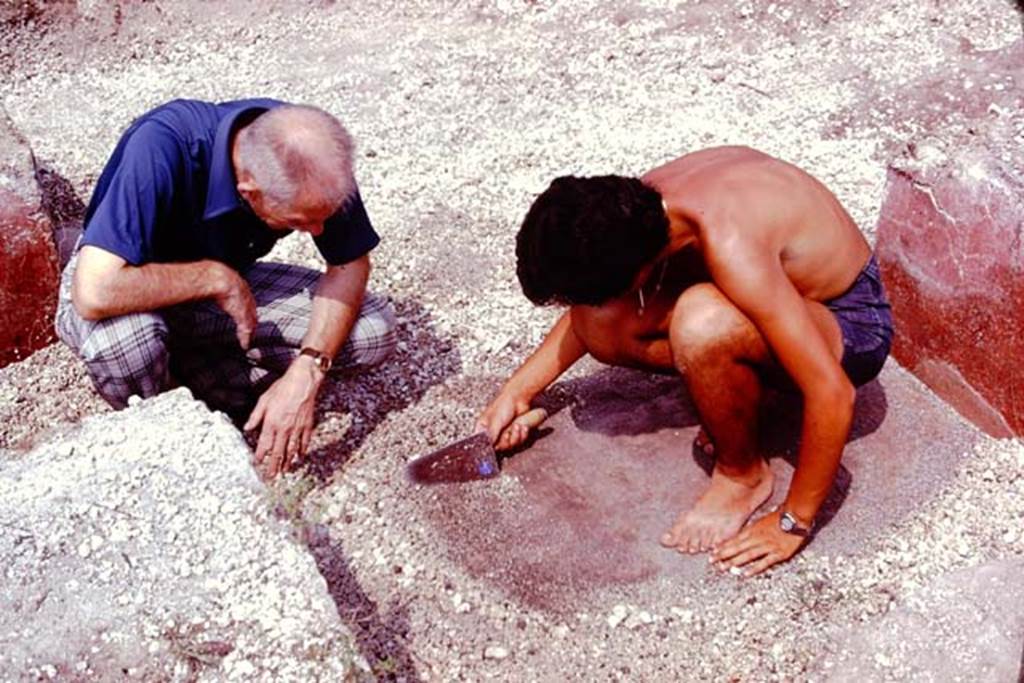
III.7 Pompeii. 1976. Carefully sifting through the lapilli. Photo by Stanley A. Jashemski.
Source: The Wilhelmina and Stanley A. Jashemski archive in the University of Maryland Library, Special Collections (See collection page) and made available under the Creative Commons Attribution-Non Commercial License v.4. See Licence and use details.
J76f0369
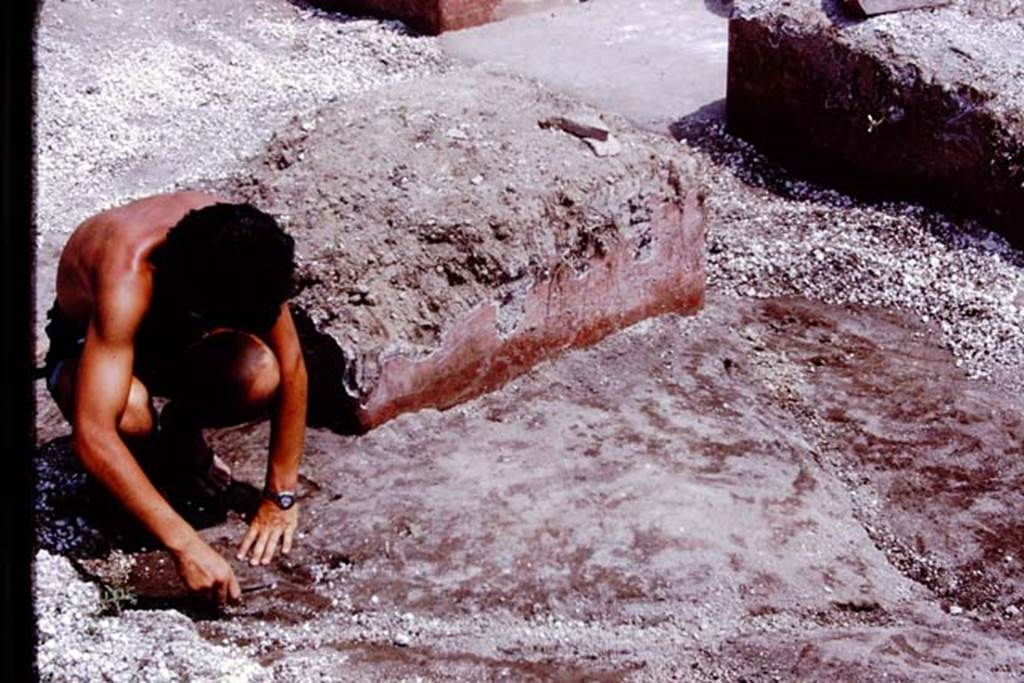
III.7 Pompeii. 1976. Examining the original soil level. Photo by Stanley A. Jashemski.
Source: The Wilhelmina and Stanley A. Jashemski archive in the University of Maryland Library, Special Collections (See collection page) and made available under the Creative Commons Attribution-Non Commercial License v.4. See Licence and use details.
J76f0423
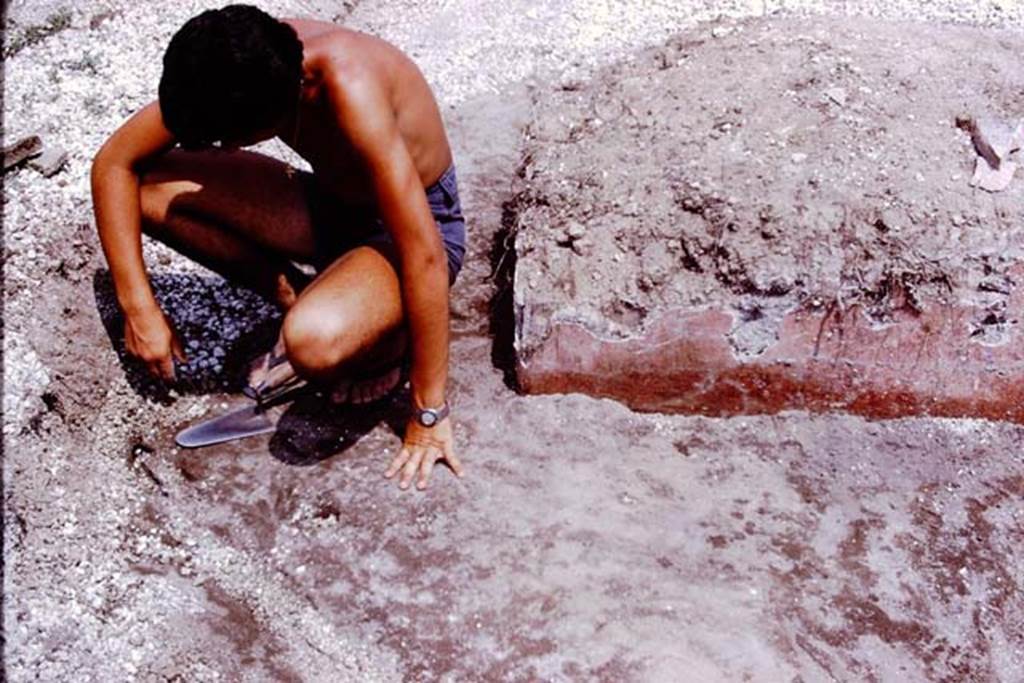
III.7 Pompeii. 1976. Examining the original soil level near the rectangular table. Photo by Stanley A. Jashemski.
Source: The Wilhelmina and Stanley A. Jashemski archive in the University of Maryland Library, Special Collections (See collection page) and made available under the Creative Commons Attribution-Non Commercial License v.4. See Licence and use details.
J76f0424
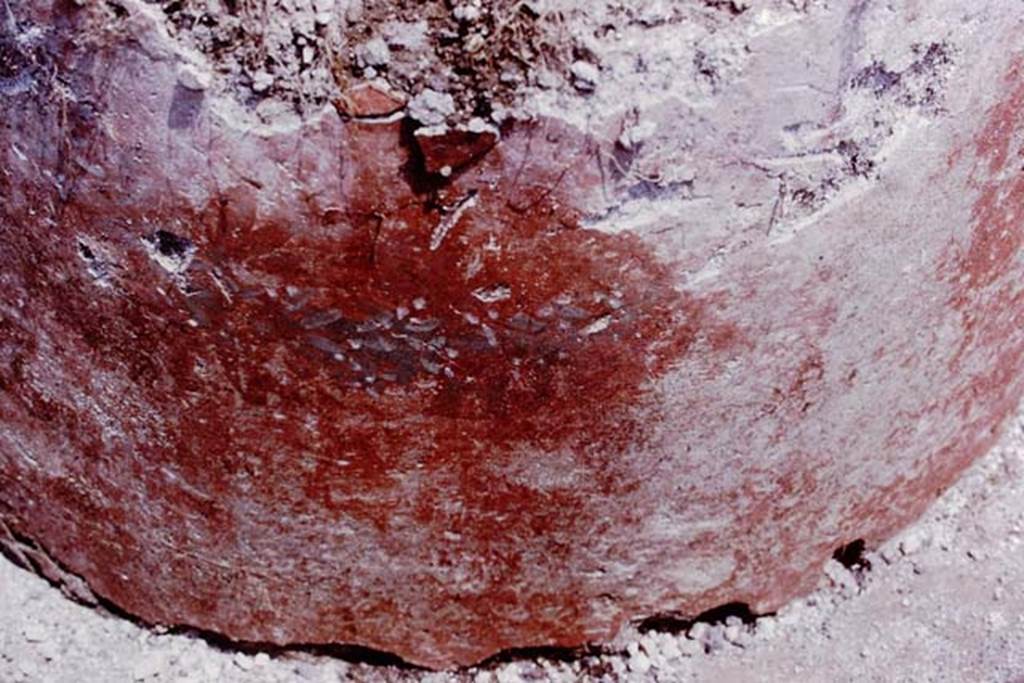
III.7 Pompeii. 1976. Painted small white myrtle flowers on circular table base. Photo by Stanley A. Jashemski.
Source: The Wilhelmina and Stanley A. Jashemski archive in the University of Maryland Library, Special Collections (See collection page) and made available under the Creative Commons Attribution-Non Commercial License v.4. See Licence and use details.
J76f0425
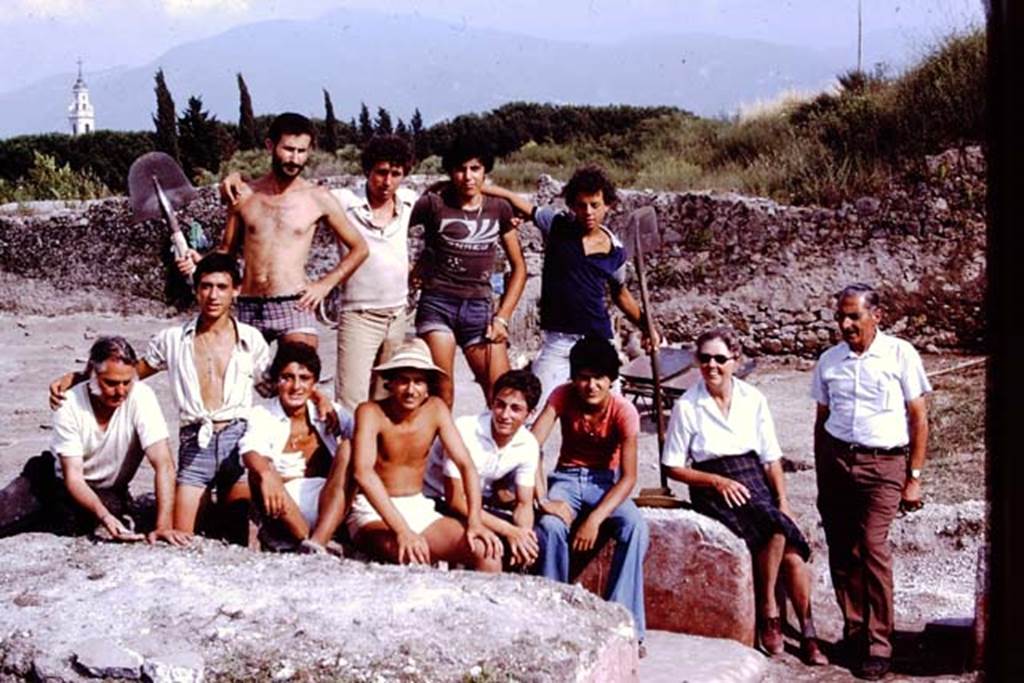
III.7 Pompeii. 1976. Wilhelmina’s workers resting on the triclinium. Photo by Stanley A. Jashemski.
Source: The Wilhelmina and Stanley A. Jashemski archive in the University of Maryland Library, Special Collections (See collection page) and made available under the Creative Commons Attribution-Non Commercial License v.4. See Licence and use details.
J76f0443
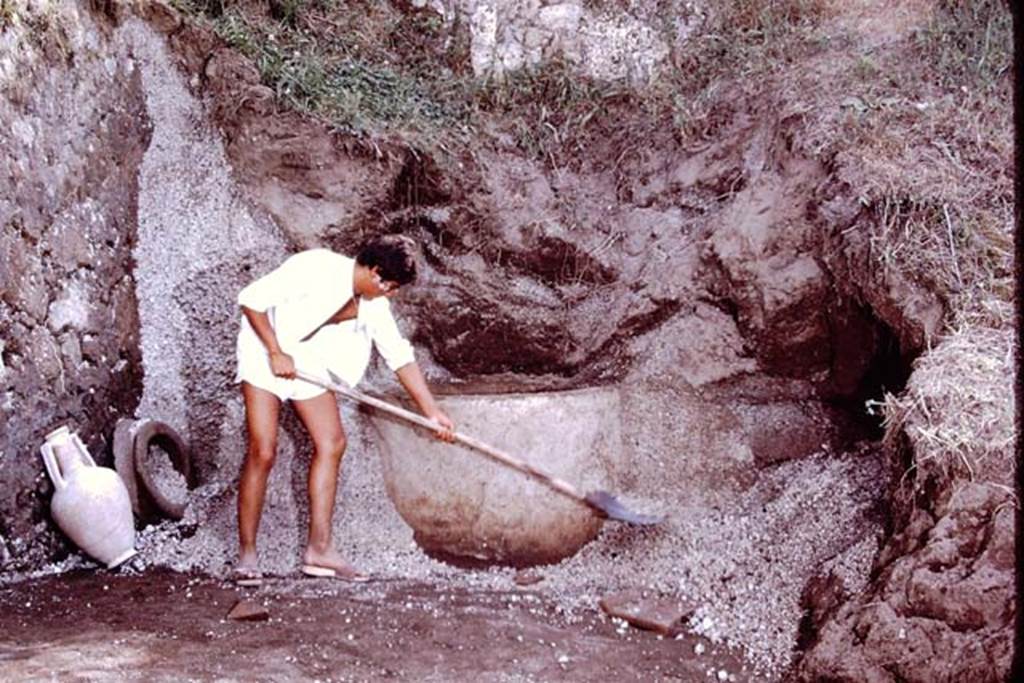
III.7 Pompeii. 1976. Discovery of a perfectly preserved cistern puteal. Photo by Stanley A. Jashemski.
Source: The Wilhelmina and Stanley A. Jashemski archive in the University of Maryland Library, Special Collections (See collection page) and made available under the Creative Commons Attribution-Non Commercial License v.4. See Licence and use details.
J76f0446
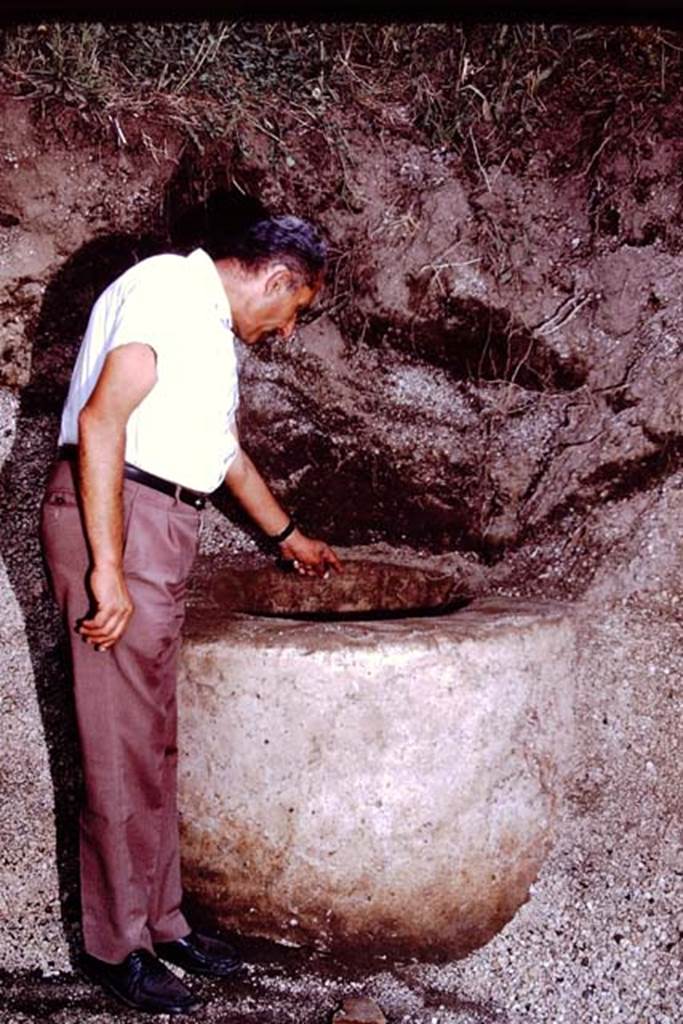
III.7 Pompeii. 1976. Sig. Sicignano examining the puteal. Photo by Stanley A. Jashemski.
Source: The Wilhelmina and Stanley A. Jashemski archive in the University of Maryland Library, Special Collections (See collection page) and made available under the Creative Commons Attribution-Non Commercial License v.4. See Licence and use details.
J76f0449
According to Wilhelmina, “we uncovered a perfectly preserved cistern puteal of an exceptional quality of cocciopesto.
The only visible sources of water for the garden were the two cisterns, the one near the triclinium and this one.
We were unable to excavate this one completely because of the pressure of the lapilli on the adjacent wall.
This cistern was probably also fed by water from the roof of the house”.
See Jashemski, W.F., 2014. Discovering the Gardens of Pompeii: Memoirs of a Garden Archaeologist, (p.247).
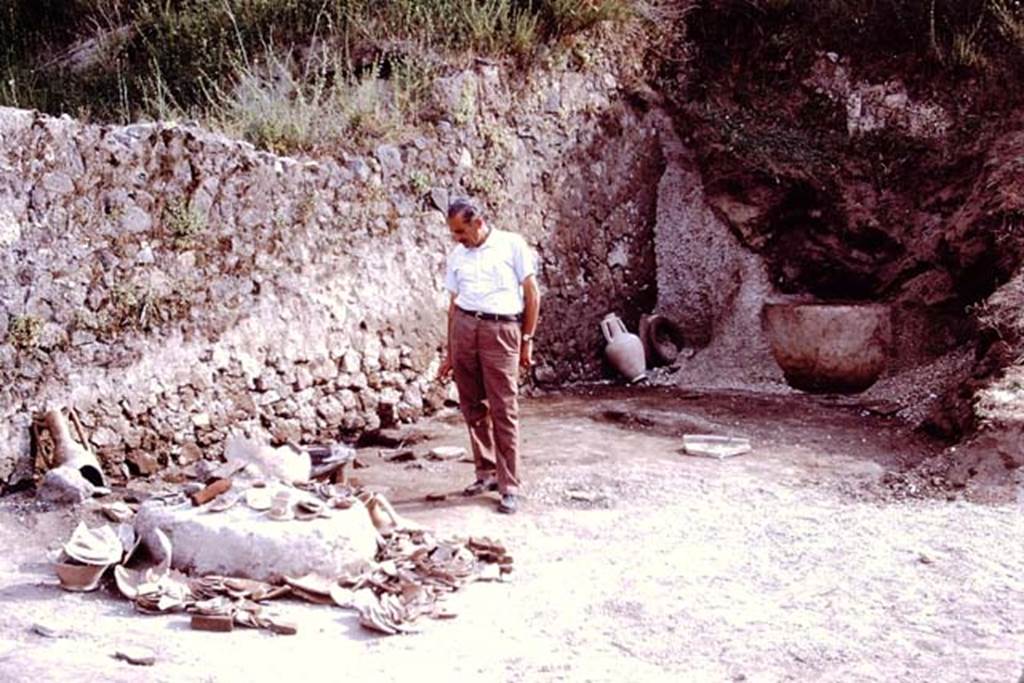
III.7 Pompeii. 1976. South-west corner of site. Photo by Stanley A. Jashemski.
Source: The Wilhelmina and Stanley A. Jashemski archive in the University of Maryland Library, Special Collections (See collection page) and made available under the Creative Commons Attribution-Non Commercial License v.4. See Licence and use details.
J76f0450
Part 1 Part 2 Jashemski 1964, 1968 Part 3 Jashemski 1976 Part 4 Jashemski 1976 Part 5 Jashemski 1976